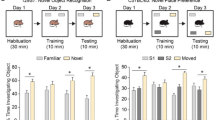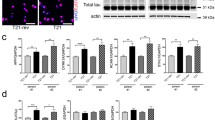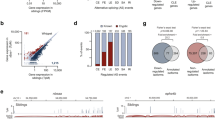Abstract
The E3 ubiquitin ligase Ube3a is an important regulator of activity-dependent synapse development and plasticity. Ube3a mutations cause Angelman syndrome and have been associated with autism spectrum disorders (ASD). However, the biological significance of alternative Ube3a transcripts generated in mammalian neurons remains unknown. We report here that Ube3a1 RNA, a transcript that encodes a truncated Ube3a protein lacking catalytic activity, prevents exuberant dendrite growth and promotes spine maturation in rat hippocampal neurons. Surprisingly, Ube3a1 RNA function was independent of its coding sequence but instead required a unique 3′ untranslated region and an intact microRNA pathway. Ube3a1 RNA knockdown increased activity of the plasticity-regulating miR-134, suggesting that Ube3a1 RNA acts as a dendritic competing endogenous RNA. Accordingly, the dendrite-growth-promoting effect of Ube3a1 RNA knockdown in vivo is abolished in mice lacking miR-134. Taken together, our results define a noncoding function of an alternative Ube3a transcript in dendritic protein synthesis, with potential implications for Angelman syndrome and ASD.
This is a preview of subscription content, access via your institution
Access options
Subscribe to this journal
Receive 12 print issues and online access
$209.00 per year
only $17.42 per issue
Buy this article
- Purchase on Springer Link
- Instant access to full article PDF
Prices may be subject to local taxes which are calculated during checkout






Similar content being viewed by others
Accession codes
Primary accessions
NCBI Reference Sequence
Referenced accessions
NCBI Reference Sequence
References
Ebert, D.H. & Greenberg, M.E. Activity-dependent neuronal signalling and autism spectrum disorder. Nature 493, 327–337 (2013).
Jiang, Y.H. et al. Mutation of the Angelman ubiquitin ligase in mice causes increased cytoplasmic p53 and deficits of contextual learning and long-term potentiation. Neuron 21, 799–811 (1998).
Matsuura, T. et al. De novo truncating mutations in E6-AP ubiquitin-protein ligase gene (UBE3A) in Angelman syndrome. Nat. Genet. 15, 74–77 (1997).
Glessner, J.T. et al. Autism genome-wide copy number variation reveals ubiquitin and neuronal genes. Nature 459, 569–573 (2009).
Sato, M. & Stryker, M.P. Genomic imprinting of experience-dependent cortical plasticity by the ubiquitin ligase gene Ube3a. Proc. Natl. Acad. Sci. USA 107, 5611–5616 (2010).
Yashiro, K. et al. Ube3a is required for experience-dependent maturation of the neocortex. Nat. Neurosci. 12, 777–783 (2009).
Wallace, M.L., Burette, A.C., Weinberg, R.J. & Philpot, B.D. Maternal loss of Ube3a produces an excitatory/inhibitory imbalance through neuron type-specific synaptic defects. Neuron 74, 793–800 (2012).
Dindot, S.V., Antalffy, B.A., Bhattacharjee, M.B. & Beaudet, A.L. The Angelman syndrome ubiquitin ligase localizes to the synapse and nucleus, and maternal deficiency results in abnormal dendritic spine morphology. Hum. Mol. Genet. 17, 111–118 (2008).
Miao, S. et al. The Angelman syndrome protein Ube3a is required for polarized dendrite morphogenesis in pyramidal neurons. J. Neurosci. 33, 327–333 (2013).
Greer, P.L. et al. The Angelman Syndrome protein Ube3A regulates synapse development by ubiquitinating arc. Cell 140, 704–716 (2010).
Margolis, S.S. et al. EphB-mediated degradation of the RhoA GEF Ephexin5 relieves a developmental brake on excitatory synapse formation. Cell 143, 442–455 (2010).
Filipowicz, W., Bhattacharyya, S.N. & Sonenberg, N. Mechanisms of post-transcriptional regulation by microRNAs: are the answers in sight? Nat. Rev. Genet. 9, 102–114 (2008).
Schratt, G. microRNAs at the synapse. Nat. Rev. Neurosci. 10, 842–849 (2009).
McNeill, E. & Van Vactor, D. MicroRNAs shape the neuronal landscape. Neuron 75, 363–379 (2012).
Seitz, H. et al. A large imprinted microRNA gene cluster at the mouse Dlk1-Gtl2 domain. Genome Res. 14, 1741–1748 (2004).
Fiore, R. et al. Mef2-mediated transcription of the miR379–410 cluster regulates activity-dependent dendritogenesis by fine-tuning Pumilio2 protein levels. EMBO J. 28, 697–710 (2009).
Schratt, G.M. et al. A brain-specific microRNA regulates dendritic spine development. Nature 439, 283–289 (2006).
Gao, J. et al. A novel pathway regulates memory and plasticity via SIRT1 and miR-134. Nature 466, 1105–1109 (2010).
Jimenez-Mateos, E.M. et al. Silencing microRNA-134 produces neuroprotective and prolonged seizure-suppressive effects. Nat. Med. 18, 1087–1094 (2012).
Bicker, S. et al. The DEAH-box helicase DHX36 mediates dendritic localization of the neuronal precursor-microRNA-134. Genes Dev. 27, 991–996 (2013).
Huibregtse, J.M., Scheffner, M., Beaudenon, S. & Howley, P.M. A family of proteins structurally and functionally related to the E6-AP ubiquitin-protein ligase. Proc. Natl. Acad. Sci. USA 92, 2563–2567 (1995).
Yamamoto, Y., Huibregtse, J.M. & Howley, P.M. The human E6-AP gene (UBE3A) encodes three potential protein isoforms generated by differential splicing. Genomics 41, 263–266 (1997).
Cooper, E.M., Hudson, A.W., Amos, J., Wagstaff, J. & Howley, P.M. Biochemical analysis of Angelman syndrome-associated mutations in the E3 ubiquitin ligase E6-associated protein. J. Biol. Chem. 279, 41208–41217 (2004).
Landers, M. et al. Regulation of the large (approximately 1000 kb) imprinted murine Ube3a antisense transcript by alternative exons upstream of Snurf/Snrpn. Nucleic Acids Res. 32, 3480–3492 (2004).
Filonova, I., Trotter, J.H., Banko, J.L. & Weeber, E.J. Activity-dependent changes in MAPK activation in the Angelman Syndrome mouse model. Learn. Mem. 21, 98–104 (2014).
Martin, K.C. & Ephrussi, A. mRNA localization: gene expression in the spatial dimension. Cell 136, 719–730 (2009).
Steward, O., Wallace, C.S., Lyford, G.L. & Worley, P.F. Synaptic activation causes the mRNA for the IEG Arc to localize selectively near activated postsynaptic sites on dendrites. Neuron 21, 741–751 (1998).
Gregory, R.I. et al. The Microprocessor complex mediates the genesis of microRNAs. Nature 432, 235–240 (2004).
Meister, G. et al. Identification of novel argonaute-associated proteins. Curr. Biol. 15, 2149–2155 (2005).
Tay, Y., Rinn, J. & Pandolfi, P.P. The multilayered complexity of ceRNA crosstalk and competition. Nature 505, 344–352 (2014).
Fone, K.C. & Porkess, M.V. Behavioural and neurochemical effects of post-weaning social isolation in rodents-relevance to developmental neuropsychiatric disorders. Neurosci. Biobehav. Rev. 32, 1087–1102 (2008).
Tay, Y. et al. Coding-independent regulation of the tumor suppressor PTEN by competing endogenous mRNAs. Cell 147, 344–357 (2011).
Denzler, R., Agarwal, V., Stefano, J., Bartel, D.P. & Stoffel, M. Assessing the ceRNA Hypothesis with Quantitative Measurements of miRNA and Target Abundance. Mol. Cell 54, 766–776 (2014).
Bosson, A.D., Zamudio, J.R. & Sharp, P.A. Endogenous miRNA and target concentrations determine susceptibility to potential ceRNA competition. Mol. Cell 56, 347–359 (2014).
Mukaetova-Ladinska, E.B., Arnold, H., Jaros, E., Perry, R. & Perry, E. Depletion of MAP2 expression and laminar cytoarchitectonic changes in dorsolateral prefrontal cortex in adult autistic individuals. Neuropathol. Appl. Neurobiol. 30, 615–623 (2004).
Raymond, G.V., Bauman, M.L. & Kemper, T.L. Hippocampus in autism: a Golgi analysis. Acta Neuropathol. 91, 117–119 (1996).
Penzes, P., Cahill, M.E., Jones, K.A., VanLeeuwen, J.E. & Woolfrey, K.M. Dendritic spine pathology in neuropsychiatric disorders. Nat. Neurosci. 14, 285–293 (2011).
Hutsler, J.J. & Zhang, H. Increased dendritic spine densities on cortical projection neurons in autism spectrum disorders. Brain Res. 1309, 83–94 (2010).
Sanders, S.J. et al. Multiple recurrent de novo CNVs, including duplications of the 7q11.23 Williams syndrome region, are strongly associated with autism. Neuron 70, 863–885 (2011).
Bevins, R.A. & Besheer, J. Object recognition in rats and mice: a one-trial non-matching-to-sample learning task to study 'recognition memory'. Nat. Protoc. 1, 1306–1311 (2006).
Poon, M.M., Choi, S.H., Jamieson, C.A., Geschwind, D.H. & Martin, K.C. Identification of process-localized mRNAs from cultured rodent hippocampal neurons. J. Neurosci. 26, 13390–13399 (2006).
Christensen, M., Larsen, L.A., Kauppinen, S. & Schratt, G. Recombinant adeno-associated virus-mediated microRNA delivery into the postnatal mouse brain reveals a role for miR-134 in dendritogenesis in vivo. Front. Neural Circuits 3, 16 (2010).
Shevtsova, Z., Malik, J.M., Michel, U., Bahr, M. & Kugler, S. Promoters and serotypes: targeting of adeno-associated virus vectors for gene transfer in the rat central nervous system in vitro and in vivo. Exp. Physiol. 90, 53–59 (2005).
Zolotukhin, S. et al. Recombinant adeno-associated virus purification using novel methods improves infectious titer and yield. Gene Ther. 6, 973–985 (1999).
Siegel, G. et al. A functional screen implicates microRNA-138-dependent regulation of the depalmitoylation enzyme APT1 in dendritic spine morphogenesis. Nat. Cell Biol. 11, 705–716 (2009).
Schratt, G.M., Nigh, E.A., Chen, W.G., Hu, L. & Greenberg, M.E. BDNF regulates the translation of a select group of mRNAs by a mammalian target of rapamycin-phosphatidylinositol 3-kinase-dependent pathway during neuronal development. J. Neurosci. 24, 7366–7377 (2004).
Dobin, A. et al. STAR: ultrafast universal RNA-seq aligner. Bioinformatics 29, 15–21 (2013).
Li, H. et al. The Sequence Alignment/Map format and SAMtools. Bioinformatics 25, 2078–2079 (2009).
Thorvaldsdóttir, H., Robinson, J.T. & Mesirov, J.P. Integrative Genomics Viewer (IGV): high-performance genomics data visualization and exploration. Brief. Bioinform. 14, 178–192 (2013).
Acknowledgements
We acknowledge technical assistance of U. Beck, E. Becker, R. Gondrum, G. Jarosch, H. Kaiser and H. Rippberger. This work was funded by grants from the European Research Council (Starting Grant “Neuromir”), the European Union FP7 (“EpimiRNA”), the Deutsche Forschungsgemeinschaft (DFG) (SFB593, FOR2107: SCHR 1136/3-1) and the Universitätsklinikum Gießen-Marburg to G.S., the DFG (FOR2107) to R.S. (SCHW 559/14-1) and M.W. (WO 1732/4-1) and the Von Behring-Röntgen-Foundation (62-0004) to S.B.
Author information
Authors and Affiliations
Contributions
J.V. performed most experiments (dendritogenesis, luciferase assays, western blots, rAAV injections, strand-specific qPCR) and analyzed the data. G.S. designed the study, supervised the project and wrote the manuscript. S.B. performed FISH, compartmentalized culture and synaptosome assays. A.A.-A. performed and analyzed patch-clamp recordings. M.L. and R.F. established and characterized the miR379–410 knockout colony. S.S. cloned and validated the Drosha shRNA construct. T.W. performed dendritogenesis assays and generated Ube3a constructs. R.S. and M.W. designed and supervised the rat behavioral studies. D.S. performed juvenile social isolation studies in rats. F.M. and C.D. analyzed deep sequencing data.
Corresponding author
Ethics declarations
Competing interests
The authors declare no competing financial interests.
Integrated supplementary information
Supplementary Figure 1 Ube3a1 RNA expression analysis by RNA sequencing.
a) Genomic view (UCSC genome browser) of the murine Ube3a locus including alternative Ube3a transcripts. The region surrounding the Ube3a1 3’UTR is boxed. Note the presence of sequence reads in the aggregate RNA-seq exon coverage panel at the genomic location of the Ube3a1 3’UTR. b) Representation of sequence reads at the location of the Ube3a1 3’UTR (boxed region in a) from rat hippocampal neurons according to ribo-minus RNA sequencing. The position of Ube3a exons 9-11, intron 11 and the UTR1 is indicated. c) Strand-specific qPCR analysis of 3’UTR1 or intron11 containing transcripts in either antisense (as) or sense orientation.
Supplementary Figure 2 Developmental expression of Ube3a1 RNA.
qPCR analysis of Ube3a1 RNA (a), Limk1 mRNA (b) Ube3a2/3 mRNA (c) expression from developing primary rat hippocampal neurons. Values are presented relative to expression at 3 DIV. N=3-5. *p<0.05, **p<0.01, ***p<0.001 (T-test).
Supplementary Figure 3 Subcellular expression of Ube3a1 RNA
a) Representative immunofluorescence analysis of cell body (upper panel) or process (lower panel) compartments from standard (left panel) or FUDR-treated (right panel) compartmentalized hippocampal neuron cultures, stained with anti-GFAP (green), anti-MAP2 (red) or Hoechst (blue). Scale bar = 50 μm. b) qPCR analysis of Ube3a1 and Ube3a2/3 with RNA from cell bodies and processes of compartmentalized hippocampal neuron cultures. Bar graphs represent the average ratio of Ube3a1 to Ube3a2/3 RNA levels from three independent preparations ± SD. c) qPCR analysis of indicated RNAs in rat P15 forebrain synaptosomes. Values are presented relative to a whole forebrain control sample. d) Conventional RT-PCR analysis of P15 whole rat forebrain (WB) and synaptosomes (SY) with primers directed against the indicated transcripts.
Supplementary Figure 4 Ube3a protein expression and knockdown validation.
a) Different fractions from a rat P15 forebrain synaptosome preparation were used for Western blotting with a monoclonal mouse anti-Ube3a antibody (Becton Dickinson) which recognizes aa. 501-712 of mouse Ube3a. Marker lane indicates 100 kD. Sup: supernatant; Pel: pellet; Syn: synaptosomes. b) HEK293 cells were transfected with the indicated constructs and analyzed for the expression of GFP-Ube3a-fusion proteins by Western blotting using the anti-Ube3a antibody described in a). c) Primary rat hippocampal neurons (13-18 DIV) were co-transfected with GFP-Ube3a-fusion constructs and dsRed and analyzed by confocal microscopy. Scale bar = 50 μm. d) HEK293 cells were co-transfected with GFP-Ube3a-fusion and indicated shRNA constructs. Expression was assessed by Western blotting using an anti-GFP antibody and an anti-Actin antibody as a loading control. e) Primary rat hippocampal neurons (10-18 DIV) were infected with rAAV expressing the indicated shRNA constructs. Expression of endogenous Ube3a protein was measured by Western blotting using an anti-Ube3a antibody that recognizes the common Ube3a N-terminus. anti-ß-actin Western served as a loading control. f) qRT-PCR analysis of indicated RNAs from hippocampal neurons infected with rAAV-Ube3a1-shRNA or rAAV-control-shRNA. Values were normalized to Gapdh expression and are presented as the ratio of Ube3a1 vs. control shRNA infected neurons ± SD. N=4 (ANOVA p=0.015323; *p<0.05 (post-hoc T-test).
Supplementary Figure 5 Regulation of dendritogenesis by GFP-Ube3a1 and GFP-Ube3a2.
a) qPCR analysis of GFP RNA expression in primary cortical neurons that had been nucleofected with the indicated GFP-Ube3a-fusion constructs. Values are presented as 40-ct and are representative for multiple independent experiments. b) Representative images of primary hippocampal neurons (DIV 13 - 18) transfected with the indicated shRNA and Ube3a1 expression constructs. c) Representative images of primary hippocampal neurons (DIV 7 - 10) transfected with the indicated expression vectors and treated with BDNF (40 ng/ml) for 48 hours prior to fixation. Scale bar = 50 μm. d) Quantification of dendrite complexity in neurons transfected with the indicated GFP expression plasmids. Values are presented relative to GFP-only transfected neurons. n=3.
Supplementary Figure 6 The Ube3a1 coding sequence (cds) is not involved in dendritogenesis.
a) anti-GFP Western blot with lysates from HEK293 cells transfected with the indicated GFP-Ube3a-fusion constructs. b) Quantification of dendrite complexity in neurons transfected with the indicated shRNA and Ube3a1 expression constructs. Values are presented relative to control shRNA transfected neurons. N=3. n.s.: not significant.
Supplementary Figure 7 Full-length blots related to Figure 4a.
a) GFP-Drosha. b) GFP. c) beta-Actin. Boxes indicate regions of the blot presented in Fig. 4a. Additional band in a) represents overexposed GFP signal.
Supplementary Figure 8 Ube3a1 ceRNA function.
a) Schematic representation of rat 3’UTRs for known miR-134 target mRNAs. Putative binding sites predicted by TargetScan (www.targetscan.org) for miR-134, miR-485 and miR-758 are marked by colored circles. The total number of additional miR379-410 seed matches is indicated. UTRs are not drawn to scale. b) Luciferase assay in primary hippocampal neurons co-transfected with Creb1-luc reporters and indicated shRNAs. Values are relative to reporter expression under basal conditions. N=7 (Creb1-luc). N=4 (Creb1-m134-luc). **p<0.01 (T-test).
Supplementary Figure 9 Quantitative PCR of miR-134 target mRNAs in neuronal cell bodies and dendrites.
a-c) Standard curves with indicated amounts of plasmids containing Pum2 (a), Limk1 (b) and Ube3a1 (c) sequence. The slope of a regression curve based on measured Ct-values is indicated in each diagram. d) Calculated RNA molecules per ng total RNA isolated from either the cell body or dendrite compartment of FUDR-treated hippocampal neurons (DIV 18) cultured on filter insets. Results from three independent experiments ± SD are shown.
Supplementary Figure 10 Full-length blots related to Figure 5f.
a) Limk1. b) Creb1. c) Pum2. d) Tubulin. Boxes indicate regions of blot presented in Fig. 5f. Membranes were cut after blotting to simultaneously probe for proteins running at different molecular weights.
Supplementary Figure 11 Genotyping and validation of miR379-410−/− mice.
a) Genotyping PCR of miR379/410−/− (KO) and wild-type (WT) mice using the indicated primer pairs. b) qPCR analysis of pre-miR-134 expression in wild-type (wt; n=7) and miR379/410−/− mice (ko; n=7). **p<0.01.
Supplementary Figure 12 Normal cortical layering in miR379-410−/– (ko) mice.
Coronal brain sections (80 mm, single hemisphere) of 8-weeks old wildtype (a), miR379-410+/− (b) or miR379-410−/− (ko; c, d) mice stained with nuclear Hoechst dye. The positions of cortical layers I-VI are indicated in the higher magnification images (right panels). No differences were observed in the general organization of the cerebral cortex or hippocampus.
Supplementary Figure 13 Model for the ceRNA function of Ube3a1 during dendritic development.
During normal activity-dependent neuronal development, Ube3a1 RNA levels steadily increase, resulting in the sequestration of dendritic miRNAs from the miR379-410 cluster, including miR-134 and miR-485. This releases protein-coding targets of these miRNAs, such as Limk1 and Pum2 mRNA, from translational repression, thereby leading to enhanced local synthesis of Limk1 and Pum2, which in turn promotes spine growth and inhibits dendrite elaboration, respectively. In conditions of Ube3a1 RNA deficiency, spine growth is suppressed whereas the brake on dendrite elaboration is loosened.
Supplementary information
Supplementary Text and Figures
Supplementary Figures 1–13 and Supplementary Tables 1–3 (PDF 2362 kb)
Rights and permissions
About this article
Cite this article
Valluy, J., Bicker, S., Aksoy-Aksel, A. et al. A coding-independent function of an alternative Ube3a transcript during neuronal development. Nat Neurosci 18, 666–673 (2015). https://doi.org/10.1038/nn.3996
Received:
Accepted:
Published:
Issue Date:
DOI: https://doi.org/10.1038/nn.3996
This article is cited by
-
An alternative splicing hypothesis for neuropathology of schizophrenia: evidence from studies on historical candidate genes and multi-omics data
Molecular Psychiatry (2022)
-
RasGRP1 promotes the acute inflammatory response and restricts inflammation-associated cancer cell growth
Nature Communications (2022)
-
Genetic and functional analyses implicate microRNA 499A in bipolar disorder development
Translational Psychiatry (2022)
-
Loss of nuclear UBE3A causes electrophysiological and behavioral deficits in mice and is associated with Angelman syndrome
Nature Neuroscience (2019)
-
Neurobiology of the major psychoses: a translational perspective on brain structure and function—the FOR2107 consortium
European Archives of Psychiatry and Clinical Neuroscience (2019)



